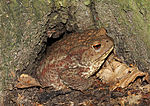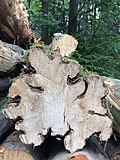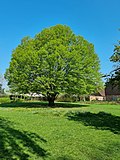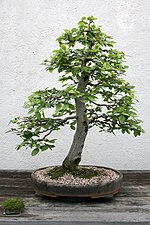|
Help
|
|
Browse
|
Search
|
Create the page "Hornbeam Carpinus" on this wiki!
- File:Bufo bufo 2015 G3.jpg (category Animals with Carpinus betulus)bufo) in the roots of hornbeam (Carpinus betulus). Ukraine. Español: Sapo común (Bufo bufo) entre las raíces del carpe (Carpinus betulus), Ucrania. Français :...(4,800 × 3,400 (7.42 MB)) - 08:49, 11 July 2024
- was here. All following user names refer to en.wikipedia. European Hornbeam (Carpinus betulus) seed catkins - photo User:MPF Legend: (cur) = this is the...(663 × 540 (77 KB)) - 17:19, 4 February 2024
- 12:19 Pinethicket 556×720× (65154 bytes) Natural range of American Hornbeam (''Carpinus caroliniana''). Digital representation of "Atlas of United States...(867 × 1,045 (282 KB)) - 17:19, 4 February 2024
- Attribution-Share Alike 4.0 truetrue English Common hornbeam (Carpinus betulus) watercolour French Charme commun (Carpinus betulus) à l'aquarelle Wikimedia username:...(2,510 × 3,461 (4.61 MB)) - 17:14, 4 February 2024
- truetrue English Hornbeam (Carpinus betulus L. 1753) - Faenza (Italy) - Malmerendi Park - 25 apr. 2021 Italian Carpino bianco (Carpinus betulus L. 1753)...(4,608 × 3,456 (6.99 MB)) - 17:11, 4 February 2024
- Picture from English Wikipedia. Description: Carpinus betulus (European Hornbeam) - Stipules Source: self-made Date: created 10. Jul. 2006 Author: Frank...(800 × 700 (264 KB)) - 17:16, 4 February 2024
- section shape of an hornbeam trunk (Carpinus betulus) ; near Prague, Czech Republic French Forme du tronc d'un charme (Carpinus betulus) en coupe transversale...(2,448 × 3,264 (2.83 MB)) - 14:04, 22 April 2024
- misidentified: Carpinus laxiflora?? Carpinus laxiflora?? Carpinus laxiflora?? Carpinus laxiflora?? Carpinus laxiflora?? Carpinus laxiflora?? Carpinus laxiflora...1,007 bytes (141 words) - 22:18, 2 May 2015
- Commons Attribution-Share Alike 4.0 truetrue English A fine specimen hornbeam (carpinus betulus) in Queen Elizabeth Gardens, Salisbury, UK. URL: https://commons...(3,000 × 4,000 (9.51 MB)) - 08:51, 29 June 2023
- Commons Attribution 4.0 truetrue English European hornbeam German Hainbuche French charme commun Latin Carpinus betulus Wikimedia username: Robert Flogaus-Faust...(2,812 × 2,096 (1.34 MB)) - 17:16, 4 February 2024
- 0CC BY 4.0 Creative Commons Attribution 4.0 truetrue English Common hornbeam (Carpinus betulus) in a tree protection tube planted 3 years and 3 months earlier...(4,800 × 3,500 (5.54 MB)) - 06:54, 3 July 2024
- Genus: Carpinus • Species: Carpinus orientalis Mill. Wikispecies has an entry on: Carpinus orientalis Vernacular names [edit wikidata 'Carpinus orientalis']...612 bytes (157 words) - 14:10, 13 December 2014
- Hainbuche (Carpinus betulus), auch Weißbuche, in Ruhland mit Ortsteil Arnsdorf. English: This gallery shows Carpinus betulus or European hornbeam, Caucasian...4 KB (114 words) - 18:44, 29 October 2023
- Genus: Carpinus • Species: Carpinus betulus L. (1753) Vernacular names [edit wikidata 'Carpinus betulus'] English: European hornbeam, Caucasian Hornbeam, Common...5 KB (395 words) - 13:16, 31 January 2023
- Carpinus betulus English determination method: SHA-1...(3,648 × 2,736 (4.6 MB)) - 17:17, 4 February 2024
- DescriptionAmerican Hornbeam Carpinus caroliniana Bark.jpg Bark of the American Hornbeamen (Carpinus caroliniana en ). Species identification performed...(500 × 259 (56 KB)) - 11:26, 6 August 2023
- File:Dülmen, Börnste, Teiche in der Heubachniederung, Baum -- 2020 -- 3500-4.jpg (category Carpinus betulus in North Rhine-Westphalia)Creative Commons Attribution-Share Alike 4.0 truetrue English Tree (Hornbeam, Carpinus betulus) in the nature reserve “Teiche in der Heubachniederung” in...(6,718 × 4,479 (28.05 MB)) - 14:14, 2 July 2024
- DescriptionEuropean Hornbeam (Carpinus betulus) (3506630028).jpg In training since 1972 Date 1 May 2009, 13:53 Source European Hornbeam (Carpinus betulus) Uploaded...(1,067 × 1,600 (754 KB)) - 15:23, 12 July 2024
- DescriptionEuropean Hornbeam (Carpinus betulus) (3493671209).jpg Some European Hornbeam trees in Wellfield Wood, Stevenage, and a young Sycamore or two...(2,304 × 1,728 (795 KB)) - 15:31, 5 July 2024
- DescriptionEuropean Hornbeam (Carpinus betulus) (3493672541).jpg Some leaves in Wellfield Wood, Stevenage. Date 2 May 2009, 16:21 Source European Hornbeam (Carpinus betulus)...(2,304 × 1,728 (803 KB)) - 11:11, 25 June 2024
Hornbeams are hardwood trees in the plant genus Carpinus in the family Betulaceae. The 30–40 species occur across much of the temperate regions of the Northern Hemisphere.
Common names
The common English name hornbeam derives from the hardness of the woods (likened to horn) and the Old English beam, "tree" (cognate with Dutch ‘’Boom’’ and German Baum).
The American hornbeam is also occasionally known as blue-beech, ironwood, or musclewood, the first from the resemblance of the bark to that of the American beech Fagus grandifolia, the other two from the hardness of the wood and the muscled appearance of the trunk and limbs.
The botanical name for the genus, Carpinus, is the original Latin name for the European species, although some etymologists derive it from the Celtic for a yoke.[2]
Description

Hornbeams are small, slow-growing, understory trees with a natural, rounded form growing 4.5–9 metres (15–30 feet) tall and wide; the exemplar species—the European hornbeam—reaches a maximum height of 32 m (105 ft).[3]: 296
Leaves are deciduous, dark-green, alternate and simple with a coarsely-serrated margin, varying from 3 to 10 centimetres (1 to 4 inches) in length. In autumn, leaves turn various shades of yellow, orange and red. Hornbeam saplings, stressed trees, and the lower branches of mature trees may exhibit marcescence—where leaves wither with autumn but abscission (leafdrop) is delayed until spring.[4]
The smooth, gray trunk and larger branches of a mature tree exhibit a distinctive muscle-like fluting.[5]
As with other members of the birch family, hornbeam flowers are wind-pollinated pendulous catkins, produced in spring. Male and female flowers are on separate catkins, but on the same tree (monoecious). Female flowers give way to distinctive clusters of winged seeds that somewhat resemble the hops-like seeds of ironwood.[6]
The fruit is a small nut about 3–6 millimetres (1⁄8–1⁄4 in) long, held in a leafy bract; the bract may be either trilobed or simple oval, and is slightly asymmetrical. The asymmetry of the seedwing makes it spin as it falls, improving wind dispersal. The shape of the wing is important in the identification of different hornbeam species. Typically, 10–30 seeds are on each seed catkin.[7][8]
Taxonomy
Formerly some taxonomists segregated them with the genera Corylus (hazels) and Ostrya (hop-hornbeams) in a separate family, Corylaceae. However, modern botanists place Carpinus in the subfamily Coryloideae of the family Betulaceae.[9][10] Species of Carpinus are often grouped into two subgenera Carpinus subgenus Carpinus and Carpinus subgenus Distegicarpus.
However, phylogentic analysis has shown that Ostrya likely evolved from a Carpinus ancestor somewhere in C. subg. Distegicarpus making Carpinus paraphyletic. The fossil record of the genus extends back to the Early Eocene, Ypresian of northwestern North America, with the species Carpinus perryae described from fossil fruits found in the Klondike Mountain Formation of Republic, Washington.[9]
Species
Accepted species:[11]
- Carpinus betulus L. – European hornbeam - Europe to Western Asia; naturalized in North America.[12]
- Carpinus caroliniana Walter – American hornbeam - Eastern North America
- Carpinus chuniana Hu – Guangdong, Guizhou, Hubei
- Carpinus cordata Blume – Sawa hornbeam - Primorye, China, Korea, Japan
- Carpinus dayongiana K.W.Liu & Q.Z.Lin – Hunan
- Carpinus eximia Nakai – Korea
- Carpinus faginea Lindl. – Nepal, Himalayas of northern India
- Carpinus fangiana Hu[13] – Sichuan, Guangxi
- Carpinus hebestroma Yamam. – Taiwan
- Carpinus henryana (H.J.P.Winkl.) H.J.P.Winkl. – southern China
- Carpinus japonica Blume – Japanese hornbeam - Japan
- Carpinus kawakamii Hayata – Taiwan, southeastern China
- Carpinus kweichowensis Hu – Guizhou, Yunnan
- Carpinus langaoensis Z. Qiang Lu & J. Quan Liu – Shaanxi, China
- Carpinus laxiflora (Siebold & Zucc.) Blume – Aka-shide hornbeam - Japan, Korea
- Carpinus lipoensis Y.K.Li – Guizhou
- Carpinus londoniana H.J.P.Winkl. – southern China, northern Indochina
- Carpinus luochengensis J.Y.Liang – Guangxi
- Carpinus mengshanensis S.B.Liang & F.Z.Zhao – Shandong
- Carpinus microphylla Z.C.Chen ex Y.S.Wang & J.P.Huang – Guangxi
- Carpinus mollicoma Hu – Tibet, Sichuan, Yunnan
- Carpinus monbeigiana Hand.-Mazz. – Tibet, Yunnan
- Carpinus omeiensis Hu & W.P.Fang – Sichuan, Guizhou
- Carpinus orientalis Mill. – Oriental hornbeam - Hungary, Balkans, Italy, Crimea, Turkey, Iran, Caucasus
- Carpinus paohsingensis W.Y.Hsia – China
- †Carpinus perryae Pigg, Manchester, & Wehr, 2003 - Ypresian, Klondike Mountain Formation
- Carpinus polyneura Franch. – southern China
- Carpinus pubescens Burkill – China, Vietnam
- Carpinus purpurinervis Hu – Guizhou, Guangxi
- Carpinus putoensis W.C.Cheng – Putuo hornbeam - Zhejiang
- Carpinus rankanensis Hayata – Taiwan
- Carpinus rupestris A.Camus – Yunnan, Guangxi, Guizhou
- Carpinus shensiensis Hu – Gansu, Shaanxi
- Carpinus shimenensis C.J.Qi – Hunan
- †Carpinus tengshongensis W.C.Cheng[14] – Pliocene Yunnan Province
- Carpinus tropicalis (Donn.Sm.) Lundell – Mexico, Central America
- Carpinus tsaiana Hu – Yunnan, Guizhou
- Carpinus tschonoskii Maxim. – Chonowski's hornbeam - China, Korea, Japan
- Carpinus turczaninovii Hance – Korean hornbeam,[15] - China, Korea, Japan
- Carpinus viminea Wall. ex Lindl. – China, Korea, Himalayas, northern Indochina
Distribution and habitat
The 30–40 species occur across much of the temperate regions of the northern hemisphere, with the greatest number of species in east Asia, particularly China. Only two species occur in Europe, only one in eastern North America, and one in Mesoamerica.[1][16][17][18][19] Carpinus betulus can be found in Europe, Turkey and Ukraine.[12]
Ecology

Hornbeams are used as food plants by the larvae of some Lepidoptera species, including autumnal moth, common emerald, feathered thorn, walnut sphinx, Svensson's copper underwing, and winter moth (recorded on European hornbeam) as well as the Coleophora case-bearers C. currucipennella and C. ostryae.[20]
Uses
Hornbeams yield a very hard timber, giving rise to the name "ironwood".[21] Dried heartwood billets are nearly white and are suitable for decorative use. For general carpentry, hornbeam is rarely used, partly due to the difficulty of working it.
The wood is used to construct carving boards, tool handles, handplane soles, coach wheels, piano actions, shoe lasts, and other products where a very tough, hard wood is required.
The wood can also be used as gear pegs in simple machines, including traditional windmills.[21] It is sometimes coppiced to provide hardwood poles. It is also used in parquet flooring and for making chess pieces.
References
- ^ a b "Carpinus L., Sp. Pl.: 998 (1753)". World Checklist of Selected Plant Families. Royal Botanic Gardens, Kew.
- ^ Gledhill D. 1985. The Names of Plants. Cambridge University Press ISBN 0521366755
- ^ Stace, C. A. (2010). New Flora of the British Isles (Third ed.). Cambridge, UK: Cambridge University Press. ISBN 9780521707725.
- ^ Cutler, Tony (2020). The world encyclopedia of trees : a reference and identification guide to 1300 of the world's most significant trees. Lorenz Books, [London, England?]. ISBN 978-0754834755.
- ^ "Carpinus caroliniana - Plant Finder". www.missouribotanicalgarden.org.
- ^ Furlow, John J. (1990). "The Genera of Betulaceae in the Southeastern United States". Journal of the Arnold Arboretum. 71 (1): 1–67. doi:10.5962/bhl.part.24925. JSTOR 43782230.
- ^ "Hornbeam, American (Musclewood) | Nebraska Forest Service". nfs.unl.edu.
- ^ The complete encyclopedia of trees of the world : the ultimate reference and identification guide to more than 1300 of the most spectacular, best-loved and unusual trees around the globe, with 3000 specially commissioned illustrations, maps and photographs. Creative Media Partners, LLC. 10 September 2021. ISBN 978-1015282605.
- ^ a b Pigg, K.B.; Manchester, S.R.; Wehr, W.C. (2003). "Corylus, Carpinus, and Palaeocarpinus (Betulaceae) from the Middle Eocene Klondike Mountain and Allenby Formations of Northwestern North America". International Journal of Plant Sciences. 164 (5): 807–822. doi:10.1086/376816. S2CID 19802370.
- ^ Forest, F.; Savolainen, V.; Chase, M. W.; Lupia, R.; Bruneau, A.; Crane, P. R. (2005). "Teasing apart molecular- versus fossil-based error estimates when dating phylogenetic trees: a case study in the birch family (Betulaceae)". Systematic Botany. 30 (1): 118–133. doi:10.1600/0363644053661850. S2CID 86080433.
- ^ "Carpinus L., Sp. Pl.: 998 (1753)". World Checklist of Selected Plant Families. Royal Botanic Gardens, Kew.
- ^ a b Carpinus betulus. 2.nd Ed., The Royal Horticultural Society, Dorling Kindersley Ltd, London, pp. 234, 235.
- ^ "Carpinus fangiana". Rogers Trees and Shrubs. Archived from the original on 2011-07-15.
- ^ Dai, J.; Sun, B.; Xie, S.; Lin, Z.g; Wu, J.; Dao, K. (2013). "A new species of Carpinus (Betulaceae) from the Pliocene of Yunnan Province, China". Plant Systematics and Evolution. 299 (3): 643–658. Bibcode:2013PSyEv.299..643D. doi:10.1007/s00606-012-0750-1. S2CID 16941126.
- ^ English Names for Korean Native Plants (PDF). Pocheon: Korea National Arboretum. 2015. p. 400. ISBN 978-89-97450-98-5. Archived from the original (PDF) on 25 May 2017. Retrieved 8 December 2016 – via Korea Forest Service.
- ^ Flora of China, Vol. 4 Page 289, 鹅耳枥属 e er li shu, Carpinus Linnaeus, Sp. Pl. 2: 998. 1753.
- ^ Flora of North America, Vol. 3, Hornbeam, Carpinus Linnaeus, Sp. Pl. 2: 998. 1753; Gen. Pl. ed. 5, 432, 1754.
- ^ "Carpinus betulus L." Altervista Flora Italiana.
- ^ "2013 BONAP North American Plant Atlas. TaxonMaps". Biota of North America Program.
- ^ Miscellaneous Publication. U.S. Department of Agriculture. 1972. p. 297.
- ^ a b Archived at Ghostarchive and the Wayback Machine: Eichhorn, Markus; Haran, Brady (2011-12-01). "The Hornbeam's Heartbeat". test-tube.org.uk. University of Nottingham. Retrieved 2012-12-30.
External links
- Eichhorn, Markus (December 2011). "Hornbeam". Test Tube. Brady Haran for the University of Nottingham.

















Recent Comments